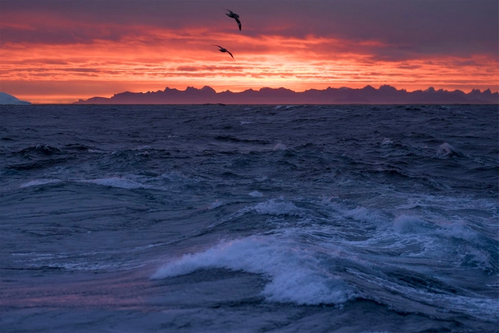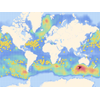Waters West of Europe Drive Ocean Overturning
The Atlantic meridional overturning circulation (MOC)—a deep-ocean process that plays a critical role in regulating Earth’s climate—is primarily driven by cooling waters west of Europe, finds a new international study published Feb. 1 in Science.
In the Atlantic MOC, warm, salty, shallow waters are carried northward from the tropics by currents and wind, and then converted into colder, fresher, deep waters that return southward through the Iceland and Irminger basins. In a departure from the prevailing scientific view, the study shows that most of the conversion from warm to cold water—or ‘overturning’ and its month-to-month variability—is occurring in regions between Greenland and Scotland, rather than in the Labrador Sea off Canada, as many past modeling studies have suggested.
Overturning variability in this northeastern section of the North Atlantic was seven times greater than in the Labrador Sea, and it accounted for 88 percent of the total variance documented across the entire North Atlantic over the 21-month study period.
These findings can help scientists better predict what changes might occur to the MOC and what the climate impacts of those changes will be, said Susan Lozier, the Ronie-Rochele Garcia-Johnson Professor of Earth and Ocean Sciences at Duke University’s Nicholas School of the Environment and adjunct scientist at the Woods Hole Oceanographic Institution (WHOI).
“To aid predictions of climate in the years and decades ahead, we need to know where this deep overturning is currently taking place and what is causing it to vary,” said Lozier, who led the observational study that produced the new data.
The Overturning in the Subpolar North Atlantic Program (OSNAP) kicked off in 2014 when an international team of oceanographers, including WHOI scientists Robert Pickart and Amy Bower, began deploying moored instruments as part of an ambitious large-scale observing system that would allow scientists for the first time to continuously measure the strength and pathways of ocean currents through the entire subpolar North Atlantic.
OSNAP, which is proposed to continue for 10 years and is funded in large part by the National Science Foundation, also includes the release of over 100 deep-drifting buoys to trace the pathways of the cold dense waters traveling southward near the sea floor. Much of the at-sea work required to put the observing system in place was carried out from the WHOI-operated research vessels Knorr (now retired) and Neil Armstrong.
“The weather at these latitudes in the North Atlantic can be nasty, even in summer, demanding highly-skilled ships’ crews, technicians, engineers and scientists working hard, night and day, as one team,” said Bower.
“Oftentimes the harsh weather systems required us to play cat and mouse with strong winds, high seas, and large numbers of icebergs—all with a ship filled to the brim with gear,” added Pickart.
Scientists from 16 research institutions from seven countries collaborated on the new study, the first published paper from the $32 million, five-year initial phase of OSNAP. The study contains data collected over a 21-month period from August 2014 to April 2016. The deep float data, which is still being processed, will shed light on the pathways of the cold, deep, dense water as it flows slowly toward the equator.
“We are expecting equally surprising results from the float data,” Bower said. “There haven’t been many measurements of current pathways in the deep ocean anywhere, and none at all of the deepest waters of the northern North Atlantic.”
Primary funding came from the U.S. National Science Foundation’s Physical Oceanography Program and the United Kingdom’s Natural Environment Research Council. Additional funding came from the European Union 7th Framework Program and Horizon 2020.
Co-authors hailed from Duke; the U.K.’s National Oceanography Center; Woods Hole Oceanographic Institution; the Scottish Association for Marine Sciences; the Royal Netherlands Institute for Sea Research and Utrecht University; Memorial University in St. John’s, Canada; GEOMAR Helmholtz Centre for Ocean Research in Kiel, Germany; and the Bedford Institute of Oceanography in Dartmouth, Canada.













 December 2025
December 2025



